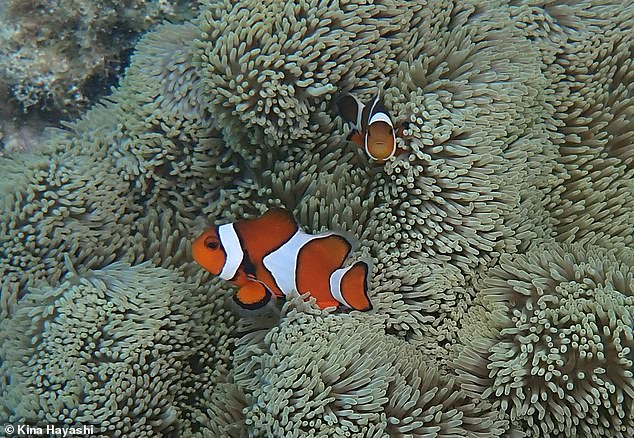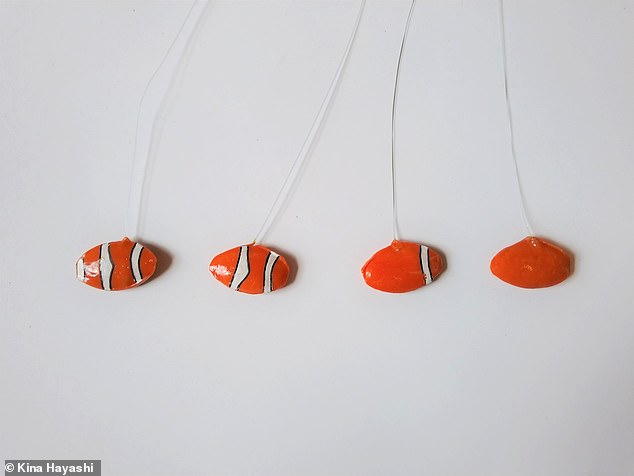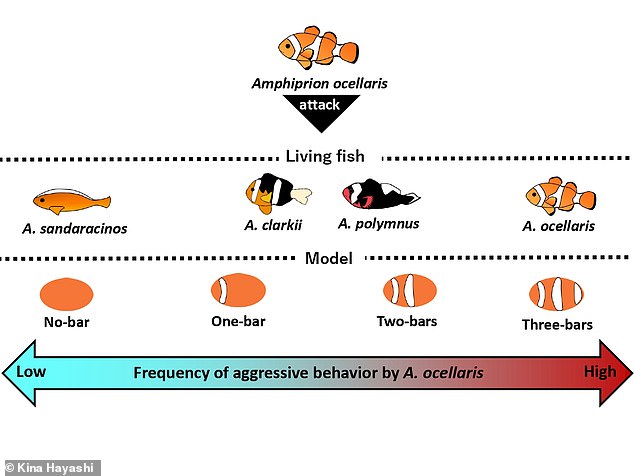Count Nemo! Clownfish can recognize the number of stripes on the bodies of other fish – and will bully competitors with different patterns, research shows
Nemo and his fellow smart clownfish can count to determine whether other fish are friends or enemies, a new study shows.
Researchers say the feisty, territorial fish can distinguish between threatening intruders and harmless cohabitants by counting the stripes across their bodies.
Scientists tested the orange fish to measure their response to fish of the same or similar species with one to three characteristic white stripes.
While keeping count, the researchers discovered that the clownfish counted the stripes of other fish and disliked those with three stripes like themselves, as well as fish with two stripes.
But they usually left those with one or no stripes alone.
Nemo and his fellow smart clownfish can count to determine whether other fish are friends or enemies, a new study shows

Researchers say the feisty, territorial fish distinguish between threatening intruders and harmless cohabitants by counting the stripes across their bodies
The Japanese scientists behind the study, published in the Journal of Experimental Biology, claim this is proof of the fish’s impressive ability to count.
While Pixar would have you believe that Nemo and his fellow clownfish cohort are timid, hospitable fish, the truth is far from that.
They are actually feisty little creatures that enthusiastically defend their anemone homes against intruders.
And while it is sometimes okay for the fish to share their habitat with clownfish of other species, it is rarely, if ever, acceptable for them to coexist with interlopers of their own species, who receive particularly icy receptions.
According to the researchers, species that live in the same locations typically have a wide range of striped patterns – from three vertical white bars to none.
Previous studies have shown that coral reef fish, including clownfish, develop their stripes so that other fish can find them in a crowd.
But researchers at the Okinawa Institute of Science and Technology sought to decipher how clownfish distinguish members of their own species from other similar striped fish.
Dr. Kina Hayashi and his colleagues raised a school of young Nemos (or common clownfish) from eggs, ensuring that the fish had never seen other species of clownfish.
When the young were six months old, Dr. Hayashi began filming their reactions to other species of clownfish – including Clarke’s clownfish (A. clarkii), orange skunk clownfish (A. sandaracinos) and saddle clownfish (A. polymnus) – as well as clownfish invaders. their own kind.
As expected, the common clownfish gave members of their own species with three white bands like them the hardest time; face four-fifths (80 percent) of the fish for up to three seconds and even maintain an 11-second standoff with one fish.

The researchers isolated small schools of three young clownfish in individual tanks and filmed their reactions on a plain orange fish model or on models painted with one, two or three white bands – keeping track of how often the fish bit and tried to chase away. the offending intruder

The researchers found that the young clownfish paid little attention to the plain orange model — similar to the lack of interest they had shown in the orange skunk clownfish — and only occasionally bit and chased the model with a single rod.
In contrast, the researchers found that invaders from other species had an easier time.
The orange skunk clownfish – which has no side stripes but a white line on the back – got off the lightest and was barely confronted.
Meanwhile, Clarke’s clownfish and saddleback clownfish – which have two and three white bars respectively – were mildly bullied.
“Common clownfish attacked their own species most often,” Dr. Hayashi noted.
But it remained a mystery to scientists how the clownfish distinguished between members of their own species and those of others.
In another series of tests, the researchers isolated small schools of three young clownfish in individual tanks and filmed their responses to a plain orange fish model or models painted with one, two or three white bands – keeping track of how often the fish bit and tried to catch the offending to chase away the intruder.
They found that the juvenile clownfish paid little attention to the plain orange model — similar to the lack of interest they had shown in the orange skunk clownfish — and only occasionally bit and chased the model with a single rod.
However, they once again upped the ante on the three-striped models, demonstrating how little they enjoyed sharing space with the three-stripe strangers who looked like themselves, while the two-striped model also received a rather unwelcome reception.
Dr. Hayashi suggested that the clownfish’s aversion to fishing with two rods could be related to their development.
Common clownfish initially form two white stripes when they are about 11 days old, before developing the third three days later.
That’s why Dr. suspects. Hayashi that clownfish that grow up with other two-striped young may see fish with two white bars as competitors that need to be chased away.
Therefore, the researchers’ study shows that young clownfish that make their homes in anemones can distinguish between species that pose a threat and those that do not, based on the number of white bars on the sides of the fish.
This allows them to defend their habitat from intruders who might try to evict them, while paying less attention to fish of other species that have little interest in establishing a home in their anemone enclosure.
